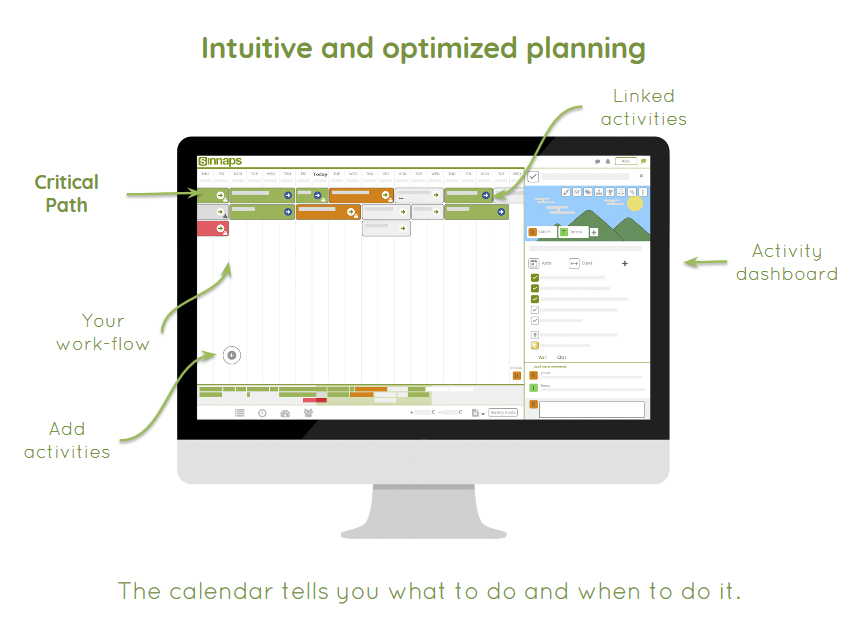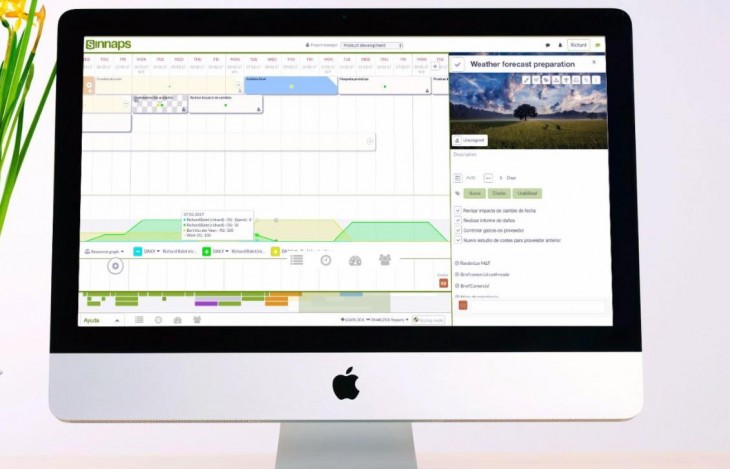Project management, in a general sense, is the task of managing projects and their running. Projects can be complex by nature and the discipline of project management holds many theories and lessons. One of the most important aspects of project management to understand are the project management phases. This article will describe the project management steps and also describe how you can start managing your projects effectively and efficiently, following project management step by step with Sinnaps, the online project management tool.
Índice
What is Project Management?
Before we get into talking about the specific project management phases, it is important to understand what project management is and what it entails. Project management involves the use of various principles, procedures and policies that are established to guide a project from its conception stage all the way along until its completion.
Planning and organisation are major parts of project management as well as the implementation of created plans. This article will give you a project management step by step guide. A project itself, is described as a specific start undertaken with parameters designed to be followed in order to produce a defined outcome. A project holds its own against ongoing processes due to the fact that it has a specific start and end date whereas processes can be ongoing for an unidentified period of time.
The plan is used to guide all aspects of a project along the project management basic steps; a path from start to finish. The ideal goal of effective project management and the role of project manager work is to reach the expected outcome of a project on time and within budget. Through anticipating certain challenges and bottlenecks of a project and coordinating an efficient and effective team, Sinnaps, the online project management app, can greatly increase the probability of a project reaching its goals in the most ideal way.
What are the Project Management Stages?
Stages are like steps. They must be followed in order to successfully complete the task of managing a project. Project management steps PMI described are in total six. The phases of project management are:
- Design
- Initiation
- Planning
- Execution
- Monitoring & Control
- Closure
Each of the project management basic steps are different. With each stage there is a different set of tasks to be completed. However, by following the intervals of project management, you can take your project from its very beginning to its very end.
Design
Before we begin to do anything in life, we must think about the task we are about to undertake. Project management is no different. It is important that the project manager has defined the project’s goal, objectives, risks, budget, timescale and approach before they and the team begin carrying out project tasks and activities.
This is essential to do as it outlines for everyone what is expected before they begin and therefore minimises the risk of any mistakes or wrongdoings occurring. The project management design phase is also a time for team members to speak up and to clear up any differing opinions so that they do not arise in the middle of the project.
Initiation
As one of the most important phases of project management, it is essential to dedicate enough time and effort to the project management initiation phase. The terms of reference within which the project will be run are set out and this decreases the likelihood of failure. The business case is declared, stakeholder expectations are set and communicated and the scope of the project is decided.
It is worth spending time on communicating and revising the business case as it will greatly improve the probability of success. Overall it is vital to spend time on this project management stage as its avoidance or poor attention will lead to problems and potentially failure.
Planning
After completing the design and initiation phase, you can move onto the project management planning phase. Effective planning is key to any project. It is important to not skip this step as the risk of failure dramatically increases. A plan that you create will act as a reference point and a guide to keep track of project progress. This will, in turn, aid in future decision-making and help with the overall organisation and effectiveness of the project.
Execution
Finally, after the three previous preparatory phases, the execution phase of project management arrives. During this phase, the project team can begin to follow the project plan and execute the tasks included in it.
Project teams work to execute the project in a way that reaches the projects goals and objectives. Most of the project work is carried out during this stage and involves the project manager and their attention greatly.
Monitoring and Control
Once your project is up and running and the project team is working on completing project work, it is important to continue monitoring progress. A project manager cannot simply leave when they see that a team has started to carry out project tasks and activities. The monitoring and controlling phase of project management is essential to its successful completion.
Keeping control is vital and this can be done by reporting any issues, risks, project progress and constantly referring to the initial business case to ensure that the project is aligning with the initial project design. It is also important to be open to introducing any changes or adaptations at this stage.
Closure
Sometimes, once the project tasks and activities have been completed, the last step, the project management closure phase, can be ignored or skipped. The formal sign-off stage holds many benefits to the overall project process. If completing a project for a customer it is essential to get confirmation from them that the project has ended and can be closed.
Once a project is closed a project manager can conduct an overall review of the project. Both the good and bad points should be recorded so that in the future, they can be referred to and used as an example of what has worked and what hasn’t worked as well.
Project Management Modules
There exist many different modules associated with project management. The PMI or Project Management Institute offers a wide array of modules such as Finance and Cost Budgeting, Scope Management, Project Control, Plan and Control Quality Management, but to name a few.
Sinnaps, the online project management app, also offers lessons on how to manage your project efficiently and effectively. These lessons are of great use for people who wish to obtain a tighter grasp on what project management truly entails and how to use Sinnaps to its full advantage when planning projects.
How to manage your project efficiently and effectively?
FREE ONLINE PROJECT MANAGEMENT COURSE

Project Management Flow Chart
Flowcharts basically display the flow project management experiences. It is a visual of the step by step progression of project management. The sequence of events is defined and how the flow of a project begins with the completion of one task leading to the beginning of another. The disadvantage to using a flowchart is that you cannot add a time interval for each stage of the project and the time intervals project management experiences are very significant.
Flowcharts usually contain:
- The beginning of the project
- Labelled project stages defined by rectangular boxes
- Decision/quality checks that are defined by diamond boxes
- A clear end to the project
The arrows that are included in the flowchart represent the direction of the project flow. If there is a decision to be made, yes and no arrows are also included that lead to each of their respective outcomes. There are various tools available online that can help you to effectively draw a project flowchart.
As you can see from any flowchart diagram of a project, it clearly portrays the various stages of project management, but lacks one of the most important aspects: time. For the efficient management of a project, time has to be included and measured at each stage in order to complete a project within a deadline.
Smaller projects that can be completed within a short period of time can make do with just using a flowchart. However, more complex and large projects require more detailed planning and the inclusion of time. In these cases, it is better to use a Gantt chart to include more detail or a Sinnaps Gantt-flow.

How Sinnaps can help your Project Management Planning?
One of the biggest advantages of using a Gantt Chart to plan projects over simply using a flowchart is the ability to include time durations. These time durations are spread across each activity and task and the project itself overall. Creating a more modern and updated version of the traditional Gantt chart can be done with Sinnaps. Task dependencies are clearly portrayed as are the various information flows and activity relationships. The Gantt-flow is user-friendly and very effective in project management. Both simple and complex project can be planned out using the Gantt-flow.
Sinnaps Gantt-flow

If tracking time is important to your project, a Gantt chart can help immensely. Sinnaps includes weekly progress reports that are automatically calculated and sent to everyone involved in the project. In this way, everyone becomes aware of how things are going with the project and whether any changes need to be introduced during project management steps and processes.
Complex projects are normally projects that include many different tasks and activities that have multiple interdependencies. Sinnaps Gantt-flow automatically creates the project critical path using CPM and PERT technologies. The critical path is highlighted at the top of the Gantt-flow and defines the tasks that are most critical to a project’s successful completion.
Sinnaps also monitors resource allocation and time management. There are performance indicators that allow everyone involved in the project to keep track of project progress. Each member is assigned to specific tasks. Within each of these tasks, there is an option to in-chat. This allows for the resolution of any doubts or worries. Apart from the in-chat feature, there is a project wall, similar to that of any social media wall which identifies any changes or updates that have been made to the project.
Along with all of the features such as the critical path, in-chat options, automatic reports, weekly updates and task relationships, creating a Gantt-flow with Sinnaps, the cloud-based project management app is easier and more effective than ever. Try it out for yourself today and see the benefits for yourself!
Now that you are aware of project management process steps, you can start your project confidently knowing exactly what step needs to come next. With the help of a Sinnaps Gantt-flow, you can easily see your project’s progress and manage each step effectively.
Here at Sinnaps, we love hearing what you think. Give this article a like if it has helped you and leave a comment sharing your opinion or asking any question you may have! We’ll be sure to get back to you! 😉
Maybe, this is interesting for you…
Project Management life cycle phases
Network Diagram Project Management

